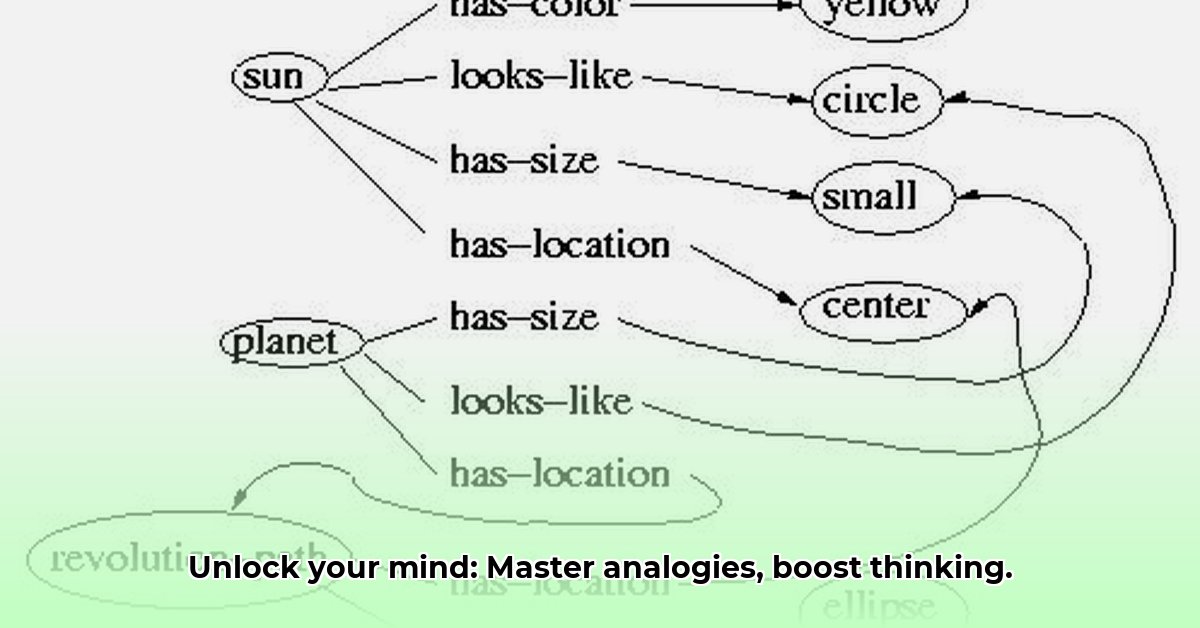
Analogies—those clever comparisons linking seemingly unrelated ideas—are your brain's secret weapon for learning and problem-solving. They act as bridges, connecting the familiar to the unfamiliar, allowing us to grasp complex concepts by relating them to things we already understand. This article explores the power of analogies, detailing how they work, the various types available, and practical strategies to enhance your analogical reasoning skills.
Understanding the Cognitive Mechanisms of Analogy
How do analogies work their magic? The process involves several key cognitive steps. First, our brains identify commonalities between two distinct sets of information; it's like spotting matching patterns in a complex puzzle. Then, these similar structures are mapped, creating a direct comparison. Finally, we apply our understanding of one situation to comprehend the other, often a new and challenging one. This isn't just memorization; it's about making insightful connections and generating creative solutions. Isn't it fascinating how our brains effortlessly bridge seemingly disparate concepts? This ability is crucial for both learning and problem-solving.
Exploring Diverse Types of Analogies
Numerous types of analogies exist, each serving a unique purpose. Metaphors, like "the world is a stage," use figurative language to create vivid comparisons, sparking imagination and bringing abstract ideas to life. Similes, employing words like "like" or "as" ("He's as strong as an ox"), offer gentler, more easily understandable comparisons. Direct analogies, such as "A hammer is to a nail as a wrench is to a bolt," highlight parallel relationships, showcasing structural equivalence. Each type offers distinct advantages; metaphors excel in creativity, similes in clarity, and direct analogies in demonstrating systemic relationships. Understanding these nuances significantly enhances communication and problem-solving. Do you find yourself using certain types of analogies more often than others?
The Role of Analogies in Education
Effective educators leverage analogies to unlock complex concepts. They transform abstract ideas into concrete, relatable examples, turning passive learning into active engagement and fostering critical thinking. Consider how a teacher might explain cell division using the analogy of a cell splitting like an amoeba. This makes the abstract concept of cellular replication easier to grasp. Analogies enhance understanding and make learning more enjoyable. However, poorly chosen analogies can be confusing; accurate selection and clear explanations are crucial for effective pedagogy. What are some memorable analogies your teachers used that helped you understand difficult concepts?
Practical Strategies for Improving Analogical Reasoning
Let's translate theoretical knowledge into actionable steps. Here's a practical guide to sharpening your analogy skills:
Cultivate Curiosity: Pay attention to analogies in daily life. Observe how writers and speakers use comparisons for effective communication. Expand your knowledge through diverse reading materials and exploring varied fields.
Practice Regularly: Engage in analogy exercises, starting with simple comparisons and gradually increasing complexity. Create your analogies; this actively strengthens comprehension.
Seek Feedback: Share your analogies and request constructive criticism. Honest feedback helps refine your skills and approach.
Study the Masters: Analyze analogies used by skilled communicators—writers, speakers, educators—to identify their effectiveness. Learn from successful methods.
Broaden Your Knowledge: A wider knowledge base provides more building blocks for analogies. Continuous intellectual curiosity empowers your analogical prowess.
Boosting Your Analogy Intelligence: A Long-Term Strategy
Consistent effort is pivotal. The following table outlines short-term and long-term goals for effective skill-building:
| Strategy | Short-Term Goals | Long-Term Goals |
|---|---|---|
| Active Analogy Creation | Create 5 new analogies daily, focusing on diverse topics. | Cultivate a daily habit of consciously seeking real-world analogies. |
| Feedback Incorporation | Actively seek feedback on at least 2 analogies weekly. | Regularly solicit and thoroughly analyze feedback for continuous improvement. |
| Knowledge Expansion | Read articles or books from at least 2 different fields each week. | Cultivate a broad and deep knowledge base across many diverse subject areas. |
Mastering analogies is a journey, not a destination. Continuous practice strengthens critical thinking, problem-solving, and creativity. Embrace the power of comparison, and watch your cognitive skills flourish.